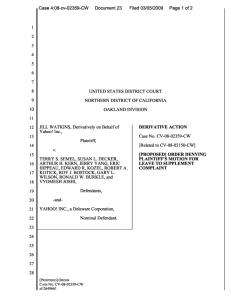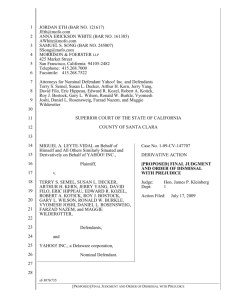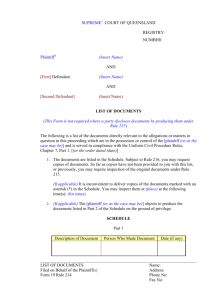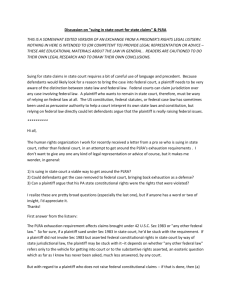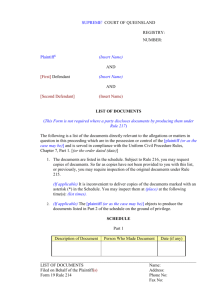Court of record example - National Liberty Alliance
advertisement
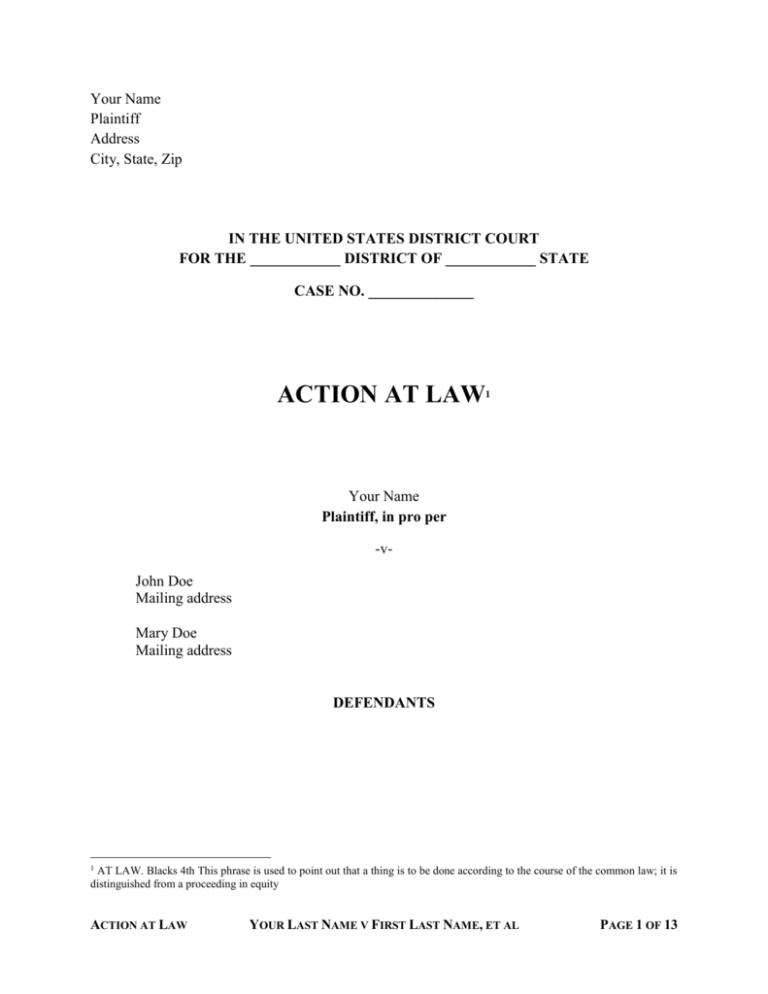
Your Name Plaintiff Address City, State, Zip IN THE UNITED STATES DISTRICT COURT FOR THE ____________ DISTRICT OF ____________ STATE CASE NO. ______________ ACTION AT LAW1 Your Name Plaintiff, in pro per -vJohn Doe Mailing address Mary Doe Mailing address DEFENDANTS 1 AT LAW. Blacks 4th This phrase is used to point out that a thing is to be done according to the course of the common law; it is distinguished from a proceeding in equity ACTION AT LAW YOUR LAST NAME V FIRST LAST NAME, ET AL PAGE 1 OF 13 TABLE OF CONTENTS Instructions to clerk ------------------------------------------------------------------------------- 1 page Summons ------------------------------------------------------------------------------------------- 1 page File on Demand ------------------------------------------------------------------------------------ 1 page Verified Action at Law ---------------------------------------------------------------------------- 13 pages Affidavit --------------------------------------------------------------------------------------------- 2 page EXHIBITS: Exhibit 1 - Name of exhibit ------------------------------------------------------------- 1 page Exhibit 2 - Name of exhibit ------------------------------------------------------------- 1 page Exhibit 3 - Name of exhibit ------------------------------------------------------------- 1 page Exhibit 4 - Name of exhibit -------------------------------------------------------------- 2 pages Exhibit 5 - Name of exhibit -------------------------------------------------------------- 2 pages Exhibit 6 - Name of exhibit -------------------------------------------------------------- 5 pages Exhibit 7 - Name of exhibit -------------------------------------------------------------- 2 pages Exhibit 8 - Name of exhibit -------------------------------------------------------------- 4 pages ACTION AT LAW YOUR LAST NAME V FIRST LAST NAME, ET AL PAGE 2 OF 13 I, Your Name, one of the People2 of Your State, in pro per3, hereinafter plaintiff, in this court of record4, proceeding according to the common law5 hereby sues for damages and charges, against John Doe; Mary Doe; herein after defendants, for fraud, conspiracy against rights:6, deprivation of rights under color of law:7, conspiracy to interfere with civil rights:8, civil action for deprivation of rights9, RICO (racketeering, extortion, misuse of permits, mail fraud)10, Frauds through postal service11, Trespass on the case12 Acts of vindictiveness, Abuse of process, Assumption of duty, Invasion of privacy and Negligence. 2 PEOPLE. People are supreme, not the state. [Waring vs. the Mayor of Savanah, 60 Georgiaat 93]; The state cannot diminish rights of the people. [Hertado v. California, 100 US 516]; Preamble to the US and NY Constitutions - We the people ... do ordain and establish this Constitution...; ...at the Revolution, the sovereignty devolved on the people; and they are truly the sovereigns of the country, but they are sovereigns without subjects...with none to govern but themselves... [CHISHOLM v. GEORGIA (US) 2 Dall 419, 454, 1 L Ed 440, 455, 2 DALL (1793) pp471-472]: The people of this State, as the successors of its former sovereign, are entitled to all the rights which formerly belonged to the King by his prerogative. [Lansing v. Smith, 4 Wend. 9 (N.Y.) (1829), 21 Am. Dec. 89 10C Const. Law Sec. 298; 18 C Em.Dom. Sec. 3, 228; 37 C Nav.Wat. Sec. 219; Nuls Sec. 167; 48 C Wharves Sec. 3, 7]. 3 Most legal dictionaries define the term "pro se" as someone who represents them self. Black's Law 4th edition, 1891 defines it "in person", therefore we used the term "in pro per", in that capacity we accept the term "pro se" not to be confused with one representing their fiction whereby the jurisdictional fraud might be assumed and statutes applied as a subject. 4 The words 'district court of the United States' commonly describes constitutional courts created under Article III of the Constitution, not the [unconstitutional] legislative courts [operating under chancery] which have long been the courts of the Territories Mookini v. U.S. , see also Longshoremen v. Juneau Spruce Corp., 324 U.S. 237; Reynolds v. U.S., 98 U.S. 145, 154; McAlister v. U.S., 141 U.S. 174; U.S. v. Burroughs, 289 U.S. 159, 163 5 COMMON LAW - As distinguished from law created by the enactment of legislatures [admiralty], the common law comprises the body of those principles and rules of action, relating to the government and security of persons and property, which derive their authority solely from usages and customs of immemorial antiquity, or from the judgments and decrees of the courts recognizing, affirming, and enforcing such usages and customs; and, in this sense, particularly the ancient unwritten law of England. [1 Kent, Comm. 492. Western Union Tel. Co. v. Call Pub. Co., 21 S.Ct. 561, 181 U.S. 92, 45 L.Ed. 765; Barry v. Port Jervis, 72 N.Y.S. 104, 64 App. Div. 268; U. S. v. Miller, D.C.Wash., 236 F. 798, 800.]; 6 18 USC §241; CONSPIRACY AGAINST RIGHTS: If two or more persons conspire to injure, oppress, threaten, or intimidate any person in any State in the free exercise or enjoyment of any right they shall be fined under this title or imprisoned not more than ten years, or both 7 18 USC §242: DEPRIVATION OF RIGHTS UNDER COLOR OF LAW: Whoever, under color of any law, statute, ordinance, regulation, or custom, willfully subjects any person in any State the deprivation of any rights shall be fined under this title or imprisoned not more than one year, or both; 8 42 USC 1985: CONSPIRACY TO INTERFERE WITH CIVIL RIGHTS: If two or more persons in any State or Territory conspire for the purpose of depriving, either directly or indirectly any persons rights the party so injured or deprived may have an action for the recovery of damages against any one or more of the conspirators. 9 42 USC 1983: CIVIL ACTION FOR DEPRIVATION OF RIGHTS: Every person who, under color of any statute, ordinance, regulation, custom, or usage, of any State subjects, or causes to be subjected, any person within the jurisdiction thereof to the deprivation of any rights, privileges, or immunities secured by the Constitution and laws, shall be liable to the party injured in an action at law. 10 18 USC Chapter 96 RICO § 1961 racketeering; section 1952 & section 1957 extortion; section 1546 misuse of permits; section 1341 mail fraud; 11 18 USC §1341 - Frauds through postal service 12 TRESPASS ON THE CASE. The form of action, at common law, adapted to the recovery of damages for some injury resulting to a party from the wrongful act of another, unaccompanied by direct or immediate force, or which is the indirect or secondary consequence of defendant's act. Commonly called, by abbreviation, "Case." Munal v. Brown, C.C.Colo., 70 F. 968; Nolan v. Railroad Co., 70 Conn. 159, 39 A. 115, 43 L.R.A. 305; New York Life Ins. Co. v. Clay County, 221 Iowa 966, 267 N.W. 79, 80. ACTION AT LAW YOUR LAST NAME V FIRST LAST NAME, ET AL PAGE 3 OF 13 JURISDICTION UNITED STATES DISTRICT COURTS “ARE ARTICLE III COURTS” There are ninety-four judicial district constitutional courts ordained and established by We the People under Article III Section 1 whereas there “shall be vested in one Supreme Court, and in such inferior courts as the Congress may from time to time ordain and establish. The judges, both of the supreme and inferior courts, shall hold their offices during good behavior13”. Congress constitutionally codified the Peoples Decree under 28 U.S. Code §132 whereas we read - Creation and composition of district courts (a) There shall be in each judicial district a district court which shall be a court of record known as the United States District Court for the (judicial) district”; and whereas, “a court of record proceeds according to the course of common (natural) law14”. TAKE JUDICIAL NOTICE - The law said “Judicial District” not “District of Columbia”. Under Article III Section 2 We the People decreed that “the judicial power shall extend to all cases, in law and equity, [chancery being contradictive was not included] arising under this Constitution, the laws of the United States, and treaties made, or which shall be made, under their authority”; And Article VI Paragraph 2 solidified that congress can only create constitutional courts functioning under the law of the land, whereas we read “This Constitution, and the laws of the United States which shall be made in pursuance thereof; and all treaties made, or which shall be made, under the authority of the United States, shall be the supreme law of the land15; and the judges in every state shall be bound thereby, anything in the Constitution or laws of any State to the contrary notwithstanding”. “Equity courts administer justice according to the system of equity16, and according to a peculiar course of procedure or practice17". This procedure or practice could be under the rules of 13 GOOD BEHAVIOR. The term "good behavior" means conduct that is authorized by law, and "bad behavior" means conduct such as the law will punish. State v. Hardin, 183 N.C. 815, 112 S.E. 593, 594. 14 Jones v. Jones, 188 Mo.App. 220, 175 S.W. 227, 229; Ex parte Gladhill, 8 Metc. Mass., 171, per Shaw, C.J. See, also, Ledwith v. Rosalsky, 244 N.Y. 406, 155 N.E. 688, 689][Black's Law Dictionary, 4th Ed., 425, 426 15 "Law of the land," "due course of law," and "due process of law" are synonymous. People v. Skinner, Cal., 110 P.2d 41, 45; State v. Rossi, 71 R.I. 284, 43 A.2d 323, 326; Direct Plumbing Supply Co. v. City of Dayton, 138 Ohio St. 540, 38 N.E.2d 70, 72, 137 A.L.R. 1058; Stoner v. Higginson, 316 Pa. 481, 175 A. 527, 531. 16 EQUITY. In its broadest and most general signification, this term denotes the spirit and the habit of fairness, justness, and right dealing which would regulate the intercourse of men with men,—the rule of doing to all others as we desire them to do to us; or, as it is expressed by the Lord. 17 See 1 Bl.Comm. 92; Dowell v. Goodwin, 22 R.I.287, 27 A. 693, 695, 51 L.R.A. 873, 84 Am.St.Rep.842 ACTION AT LAW YOUR LAST NAME V FIRST LAST NAME, ET AL PAGE 4 OF 13 chancery or the rules of common law, the latter was Decreed by the People and articulated under Article VI titled “Law of the Land”, the former was deliberately excluded by the People, it being repugnant to common law. In conclusion all United States District Courts are Courts of Law18 and must proceed under common law19 and not chancery, thereby finding the 1789 Judiciary Act Chapter XX Section 15 null and void whereas the legislators exceeded their authority when they unlawfully gave the judiciary “POWER” to proceed according to the “rules of chancery” contrary to law. This is long-established in Marbury v Madison as null and void, thus finding all judges who proceed according to chancery knowingly act under color of law20 thereby hijacking their victims to foreign courts of fiction and are in bad behavior without immunity. This was make unquestionably crystal-clear by the following United States Supreme Court case ..."The words 'district court of the United States' commonly describes constitutional courts created under Article III of the Constitution, not the [unconstitutional] legislative courts [operating under chancery] which have long been the courts of the Territories21.” “William Blackstone - a legal maxim - Every right when with-held must have a remedy, and every injury it’s proper redress22.” … “Indeed, no more than an affidavit is necessary to make the prima facie case23.” By the authority of Article III Section 2 federal district Article III courts of record have jurisdiction in “all cases, in law and equity, arising under this Constitution, the laws of the United States, and treaties made, or which shall be made, under their authority;” Therefore under Amendment V it is the constitutional jurisdiction and duty of this court to 18 Court of "Law" means Court of Common Law - a court for the People CORAM IPSO REGE Common law - As distinguished from ecclesiastical law, it is the system of jurisprudence administered by the purely secular tribunals. As concerns its force and authority in the United States, the phrase designates that portion of the common law of England (including such acts of parliament as were applicable) which had been adopted and was in force here at the time of the Revolution. This, so far as it has not since been expressly abrogated, is recognized as an organic part of the jurisprudence of most of the United States. [Industrial Acceptance Corporation v. Webb, Mo.App., 287 S.W. 657, 660]. 20 COLOR OF LAW. [Black's Law 4th edition, 1891] -- The appearance or semblance, without the substance, of legal right. [State v. Brechler, 185 Wis. 599, 202 N.W. 144, 148] Misuse of power, possessed by virtue of state law and made possible only because wrongdoer is clothed with authority of state, is action taken under "color of state law." (Atkins v. Lanning, 415 F. Supp. 186, 188) 21 Mookini v. U.S. , see also Longshoremen v. Juneau Spruce Corp., 324 U.S. 237; Reynolds v. U.S., 98 U.S. 145, 154; McAlister v. U.S., 141 U.S. 174; U.S. v. Burroughs, 289 U.S. 159, 163 22 5 U.S. 137, Marbury v. Madison 23 United States v. Kis, 658 F.2d 526, 536 (7th Cir. 1981); Cert. Denied, 50 U.S. L. W. 2169; S. Ct. March 22, 1982 19 ACTION AT LAW YOUR LAST NAME V FIRST LAST NAME, ET AL PAGE 5 OF 13 protect People from being deprived of life, liberty, or property, without due process of law 24; Any Judge or Magistrate that denies said duty under color of law is guilty of a felony. “In the third volume of his Commentaries, page 23, Blackstone states two cases in which a remedy is afforded by mere operation of law. "In all other cases," he says, it is a general and indisputable rule that where there is a legal right, there is also a legal remedy by suit or action at law whenever that right is invaded. And afterwards, page 109 of the same volume, he says, I am next to consider such injuries as are cognizable by the Courts of common law. And herein I shall for the present only remark that all possible injuries whatsoever that did not fall within the exclusive cognizance of either the ecclesiastical, military, or maritime tribunals are, for that very reason, within the cognizance of the common law courts of justice, for it is a settled and invariable principle in the laws of England that every right, when withheld, must have a remedy, and every injury its proper redress25"... "The Government of the United States has been emphatically termed a government of laws, and not of men. It will certainly cease to deserve this high appellation if the laws furnish no remedy for the violation of a vested legal right26." … that statutes which would deprive a citizen of the rights of person or property without a regular trial, according to the course and usage of common law, would not be the law of the land27.” “Henceforth the writ which is called Praecipe (motion to dismiss for any reason) shall not be served on any one for any holding so as to cause a free man to lose his court28”. FOR CAUSE29 and LAWFUL REMEDY30 - Article III Section 2 The judicial power shall extend to all cases, in law and equity, arising under this Constitution; and violation of plaintiff’s unalienable rights took place in Dutchess County, therefore this Court of Record in the Federal Southern District Court is the proper venue for hearing this case. 24 Amendment V - No person shall ... be deprived of life, liberty, or property, without due process of law; 5 U.S. 137, Marbury v. Madison 26 Marbury v. Madison, 5 U.S. 137 (1803) 27 Hoke vs. Henderson,15, N.C.15,25 AM Dec 677 28 Magna Carta, Article 34 29 FOR CAUSE Means for reasons which law and public policy recognize as sufficient warrant for removal and such cause is "legal cause" and not merely a cause which the appointing power in the exercise of discretion may deem sufficient. State ex rel. Nagle v. Sullivan, 98 Mont. 425, 40 P.2d 995, 998, 99 A.L.R. 321. 30 LEGAL REMEDY A remedy available, under the particular circumstances of the case, in a court of law, as distinguished from a remedy available only in equity. See State v. Sneed,. 105 Tenn. 711, 58 S.W. 1070. 25 ACTION AT LAW YOUR LAST NAME V FIRST LAST NAME, ET AL PAGE 6 OF 13 LAW OF THE CASE Plaintiffs accept the oaths31 to support and uphold the Constitution for the United States of America, and bonds of “all” the officers of this court including magistrate, attorneys, bailiff and are directed to take judicial notice32 of the following: i. SUPREMACY CLAUSE: This Constitution, and the laws of the United States which shall be made in pursuance thereof; and all treaties made, or which shall be made, under the authority of the United States, shall be the supreme law of the land; and the judges in every state shall be bound thereby, anything in the Constitution or laws of any State to the contrary notwithstanding. ii. Marbury v. Madison 5 U.S. 137 (1803) which concluded “… Thus, the particular phraseology of the constitution of the United States confirms and strengthens the principle, supposed to be essential to all written constitutions, that a law repugnant to the constitution is void, and that courts, as well as other departments, are bound by that instrument.” after more than 200 years this decision still stands iii. … that statutes which would deprive a citizen of the rights of person or property without a regular trial, according to the course and usage of common law, would not be the law of the land. [Hoke vs. Henderson,15, N.C.15,25 AM Dec 677]. iv. "Where rights secured by the Constitution are involved, there can be no rule making or legislation which would abrogate them" v. [Miranda v. Arizona, 384 U.S. 436, 491] Constitution shall receive a liberal interpretation in favor of the citizen as is especially true in respect to those provisions that were designed to save guard citizen in both person and property [Jurisprudence volume 16, Constitutional Law, section 97] vi. The un-codified common law is the superior law of the people and the codified civil law is the special or inferior law of the government and its agency. Because the United States 31 Oaths: Article VI: "This Constitution, and the laws of the United States... shall be the supreme law of the land; and the judges in every State shall be bound thereby; anything in the Constitution or laws of any State to the contrary notwithstanding... All executive and judicial officers, both of the United States and of the several States, shall be bound by oath or affirmation to support this Constitution." 32 Judicial notice, or knowledge upon which a judge is bound to act without having it proved in evidence. - Black's Law 4th edition. ACTION AT LAW YOUR LAST NAME V FIRST LAST NAME, ET AL PAGE 7 OF 13 Constitution guarantees to each state a republican form of government33 (not a democracy)34, Article IV, section 4, of the United States Constitution, the law of the people outranks the law of the government.35 Access to the common law is guaranteed by the U.S. Constitution.36 vii. RIGHT TO PRACTICE LAW - The American Bar Association (ABA), founded August 21, 1878, is a voluntary association of lawyers, and was incorporated in 1909 in the state of Illinois. The state does not accredit the law schools or hold examinations and has no control or jurisdiction over the ABA or its members. The ABA accredits all the law schools, holds their private examinations, selects the students they will accept in their organization, and issues them so-called license for a fee; but does not issue state licenses to lawyers. The Bar is the only authority that can punish or disbar a Lawyer not the state. The ABA also selects the lawyers that they consider qualified for Judgeships and various other offices in the State. Under fiction of law only the Bar Association or their designated committees can remove any of these lawyers from public office. This is a tremendous amount of power for a private union to control and because of this unchecked power RICO run rampant throughout our government at every level, and We the People intend on extinguishing it. The United States Constitution does not give anyone the right to a lawyer or the right to counsel, or the right to any other "hearsay substitute". The 6th Amendment is very specific, that the accused only has the right to the “assistance of counsel” and this assistance of counsel can be anyone the accused chooses without limitations. 33 "Republican government. One in which the powers of sovereignty are vested in the people and are exercised by the people, either directly, or through representatives chosen by the people, to whom those powers are specially delegated. In re Duncan, 139 U.S. 449, 11 S.Ct. 573, 35 L.Ed. 219; Minor v. Happersett, 88 U.S. (21 Wall.) 162, 22 L.Ed. 627." Black's Law Dictionary, Fifth Edition, p. 626. 34 Democracy. That form of government in which the sovereign power resides in and is exercised by the whole body of free citizens directly or indirectly through a system of representation, as distinguished from a monarchy, aristocracy, or oligarchy. Black's Law Fifth Ed, pp. 388-389. 35 This is exemplified in U.S. Constitution, Amendment VII, which prohibits any court’s review of a determination of facts by a jury in law. 36 Constitution for the United States of America, Amendment VII ACTION AT LAW YOUR LAST NAME V FIRST LAST NAME, ET AL PAGE 8 OF 13 "The term [liberty] ... denotes not merely freedom from bodily restraint but also the right of the individual to contract, to engage in any of the common occupations of life, to acquire useful knowledge, to marry, to establish a home and bring up children, to worship God according to the dictates of this own conscience... The established doctrine is that this liberty may not be interfered with, under the guise of protecting public interest, by legislative action37." … "The practice of law cannot be licensed by any State38." … “a State cannot exclude a person from the practice of law or from any other occupation in a manner or for reasons that contravene the Due Process Clause 39.” … "The practice of law is an occupation of common right40." … Therefore "there can be no sanction or penalty imposed upon one because of his exercise of Constitutional Rights41." “Litigants can be assisted by unlicensed laymen during judicial proceedings 42”… “Members of groups who are competent non-lawyers can assist other members of the group achieve the goals of the group in court without being charged with "unauthorized practice of law43." … “A next friend is a person who represents someone who is unable to tend to his or her own interest44.” GENERAL ALLEGATIONS OF LAW 1) Admit or deny - make your statement keep it simple seeking one word or phrase answer". 2) Admit or deny - make your statement keep it simple seeking one word or phrase answer". 3) Admit or deny - make your statement keep it simple seeking one word or phrase answer". 4) Admit or deny - make your statement keep it simple seeking one word or phrase answer". 5) Admit or deny - make your statement keep it simple seeking one word or phrase answer". 6) Admit or deny - make your statement keep it simple seeking one word or phrase answer". 7) Admit or deny - make your statement keep it simple seeking one word or phrase answer". 8) Admit or deny - make your statement keep it simple seeking one word or phrase answer". 37 Meyer v. Nebraska, 262 U.S. 390, 399, 400 Schware v. Board of Examiners, United State Reports 353 U.S. pages 238, 239 39 Schware v. Board of Bar Examiners, 353 U.S. 232 (1957) 40 Sims v. Aherns, 271 SW 720 (1925) 41 Sherar v. Cullen, 481 F. 2d 946 (1973) 42 Brotherhood of Trainmen v. Virginia ex rel. Virginia State Bar, 377 U.S. 1; v. Wainwright, 372 U.S. 335; Argersinger v. Hamlin, Sheriff 407 U.S. 425 43 NAACP v. Button, 371 U.S. 415); United Mineworkers of America v. Gibbs, 383 U.S. 715; and Johnson v. Avery, 89 S. Ct. 747 (1969) 44 Federal Rules of Civil Procedures, Rule 17, 28 USCA "Next Friend 38 ACTION AT LAW YOUR LAST NAME V FIRST LAST NAME, ET AL PAGE 9 OF 13 9) Admit or deny - make your statement keep it simple seeking one word or phrase answer". 10) Admit or deny - make your statement keep it simple seeking one word or phrase answer". 11) Admit or deny - make your statement keep it simple seeking one word or phrase answer". 12) Admit or deny - make your statement keep it simple seeking one word or phrase answer". GENERAL ALLEGATIONS OF FACTS 13) On or about April 26th 2013 write details; (see Exhibit 1) keep it simple looking for one word or phrase answers. 14) On or about August 7th 3013 write details; (see Exhibit 2) keep it simple looking for one word or phrase answers. 15) Write details keep it simple looking for one word or phrase answers. 16) Write details keep it simple looking for one word or phrase answers. 17) Write details keep it simple looking for one word or phrase answers. 18) Write details keep it simple looking for one word or phrase answers. 19) Write details keep it simple looking for one word or phrase answers. 20) Write details keep it simple looking for one word or phrase answers. 21) Write details keep it simple looking for one word or phrase answers. 22) Write details keep it simple looking for one word or phrase answers. 23) Write details keep it simple looking for one word or phrase answers. 24) Write details keep it simple looking for one word or phrase answers. 25) Write details keep it simple looking for one word or phrase answers. ACTION AT LAW YOUR LAST NAME V FIRST LAST NAME, ET AL PAGE 10 OF 13 COUNT 1: CONSPIRACY AGAINST RIGHTS45 Plaintiff restates the foregoing paragraphs 13-18. Defendants conspired to injure, oppress, threaten, and intimidate plaintiff, one of the People of Your State in the free exercise and enjoyment of plaintiff’s unalienable right to be left alone and right to due process. COUNT 2: DEPRIVATION OF RIGHTS UNDER COLOR OF LAW: Plaintiff restates the foregoing paragraphs 13-18. Defendants under color of law willfully deprived plaintiff of their free exercise and enjoyment of plaintiff’s unalienable right to be left alone and due process. COUNT 3: CONSPIRACY TO INTERFERE WITH CIVIL RIGHTS: Plaintiff restates the foregoing paragraphs 13-18. Defendants conspired for the purpose of depriving plaintiff’s free exercise and enjoyment of plaintiff’s unalienable right to be left alone and due process. COUNT 4: CIVIL ACTION FOR DEPRIVATION OF RIGHTS Plaintiff restates the foregoing paragraphs 13-18. Defendants conspired for the purpose of depriving plaintiff’s free exercise and enjoyment of plaintiff’s unalienable right to be left alone and due process. COUNT 5: RICO RACKETEERING, EXTORTION AND MAIL FRAUD Plaintiff restates the foregoing paragraphs 13-18. Defendants via postal service to harassed plaintiff by letters and forms to extort money. 45 18 USC §241; CONSPIRACY AGAINST RIGHTS: If two or more persons conspire to injure, oppress, threaten, or intimidate any person in any State in the free exercise or enjoyment of any right they shall be fined under this title or imprisoned not more than ten years, or both ACTION AT LAW YOUR LAST NAME V FIRST LAST NAME, ET AL PAGE 11 OF 13 COUNT 6: TRESPASS ON THE CASE46 Plaintiff restates the foregoing paragraphs 13-18. Plaintiff was injured by defendants acts of extortion and threat of enforcement without due process, thereby violating plaintiffs free exercise and enjoyment of unalienable right to be left alone and due process. COUNT 7: ACTS OF VINDICTIVENESS Plaintiff restates the foregoing paragraphs 13-18. Plaintiff was targeted because plaintiff is a liberty group leader. COUNT 8: FRAUD Plaintiff restates the foregoing paragraphs 13-18. Defendants were informed by verified notice and demand that their written conclusions were false and damaging. Defendants refused to correct their false statements and continued to intimidate and harass plaintiff to submit and pay erroneous bills. COUNT 9: ABUSE OF PROCESS Plaintiff restates the foregoing paragraphs 13-18. Defendants illegally perverted the legal system against plaintiff. Defendants had ulterior motive exercising a perverted use of the system, plaintiff suffered damage as a direct result. COUNT 10: ASSUMPTION OF DUTY Plaintiff restates the foregoing paragraphs 13-18. Defendants had an obligation to take corrective action but failed to exercise reasonable care. Defendants by their abuse of process created a chilling effect putting in jeopardy life limb and property causing plaintiff to suffered harm resulting from defendant’s failure to exercise reasonable care to perform the services defendants were obligated to perform. 46 TRESPASS ON THE CASE. The form of action, at common law, adapted to the recovery of damages for some injury resulting to a party from the wrongful act of another, unaccompanied by direct or immediate force, or which is the indirect or secondary consequence of defendant's act. Commonly called, by abbreviation, "Case." Munal v. Brown, C.C.Colo., 70 F. 968; Nolan v. Railroad Co., 70 Conn. 159, 39 A. 115, 43 L.R.A. 305; New York Life Ins. Co. v. Clay County, 221 Iowa 966, 267 N.W. 79, 80. ACTION AT LAW YOUR LAST NAME V FIRST LAST NAME, ET AL PAGE 12 OF 13 COUNT 11: INVASION OF PRIVACY Plaintiff restates the foregoing paragraphs 13-18. Defendant publicized plaintiff’s private affairs by reporting an illegal lien, without due process, to credit agencies causing economic damages COUNT 12: NEGLIGENCE Plaintiff restates the foregoing paragraphs 13-18. Defendant owed plaintiff a legal duty to exercise reasonable care and instead defendants breached their duty of care and plaintiff suffered damages as a direct result of the breach. WHEREFORE plaintiff lawfully moves this court of record for a default judgment as follows: The agreed upon compensation for damages and injury for causing undue stress upon plaintiff and family is $25,000.00 for each of the following violation from each party involved. And should an unlawful lien be placed upon me and or my property without due process in a court of law the damages will be four times the amount of lien. 1) Defendants failed to provide Proof of Claim or cease. 2) Defendants failed to provide Notice Concerning Fiduciary Relationship or cease. 3) Defendants failed to correct the record. 4) Defendants continued under color of law without constitutional authority in violation of 18 USC §241, 18 USC §242, 42 USC §1983, 42 USC §1985 and 42 USC §1986 ____________________________________ Your Name, plaintiff NOTARY Your State, Your County on this _________________ day of ________________________ 2015 before me _________________________, the subscriber, personally appeared Your Name to me known to be the living man describe in and who executed the forgoing instrument and sworn before me that he executed the same as his free will act and deed. __________________________________ Notary (Notary Seal) ACTION AT LAW My commission expires: _______ YOUR LAST NAME V FIRST LAST NAME, ET AL PAGE 13 OF 13

